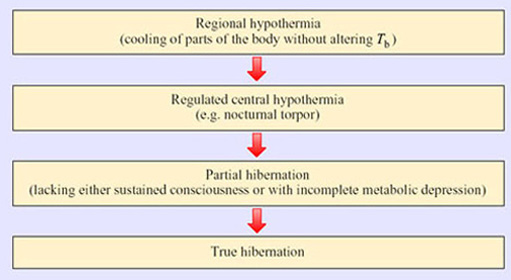1 Hibernation and torpor: An introduction
This course examines hibernation, a special form of adaptation that animals can make to the ecological demands of remaining in a chosen habitat in winter. Hibernation is a state which enables energy-efficient survival when ambient temperatures are so low that foraging or simply maintaining normal core body temperature and basal metabolic rate are either energetically too costly or impossible.
Polar endotherms can maintain a high T b even when living actively at sub-zero temperatures. Such animals have very good thermal insulation and may have a plentiful food supply to sustain the increased thermogenesis needed to maintain a large difference between T a and T b. For many animals, however, the food supply in a cold environment becomes scarce or inaccessible beneath snow or ice.
Question 1
What are the options for surviving a very cold winter?
Answer
To remain active. This strategy is possible for an animal with appropriate insulation, considerable energy reserves and the ability to compete successfully for a continuing food source. The arctic fox and the emperor penguin are examples of such animals.
To migrate to another habitat for the duration of an inhospitably cold season. This strategy is possible if the animal has sufficient mobility to leave the extreme latitudes as the available food dwindles. Many birds and bats adopt this strategy.
To endure the periods of low temperature extremes in the chosen habitat at low metabolic cost – by reducing T b, locomotion and other life functions at all levels. The use of this approach, to varying extents, is seen in a huge and diverse group of birds and mammals. It has also been adopted by poikilothermic vertebrates and invertebrates, though often for different reasons.
Option 3 is adaptive hypothermia, as seen in torpor and hibernation. Small homeotherms living at latitudes (or altitudes) at which they experience long periods of cold weather and lack of solar radiation have few options. Consider the problems a small animal is likely to encounter compared with a large one. It has a relatively high surface area to volume ratio and therefore a high potential for heat loss: even at moderate T a, it normally has a high metabolic rate and cannot carry enough really effective insulation, whether of fur, feathers or blubber. Some species can survive in burrows if they can emerge regularly and find enough plant material to eat beneath the snow, but even these animals are likely to use energy-conserving strategies for much of the time. Thus, small rodents and insectivores, for example, have little choice but to exploit option (iii) above, uncoupling their homeothermic mechanisms or resetting the critical body temperature (Tc): in other words adaptive hypothermia.
Thermal adaptation in animals overcomes the ecological and bioenergetic constraints of living in extreme climates. For warm-blooded vertebrates, evolution has generated almost every imaginable approach to this problem, and the adaptations adopted for each species reflect different approaches to the evolutionary cost-benefit analysis of variations on conventional endothermy. Whilst most hibernating endotherms lower the temperature of all or parts of their bodies by between 5 and 25° C, many ectotherms and some mammals are characterized by their ability to depress their T b to below the freezing point of water. In either situation, physiological adaptations must include:
thermoregulatory systems with control mechanisms different from, or with the ability to override, those which operate in the seasons when the animal is euthermic;
biochemical and cellular control mechanisms capable of protecting tissues against damage, and compensating for energetic and metabolic disadvantages which are manifested at low body temperatures.
The terminology used to describe the different forms in which adaptive hypothermia is observed in animals is complicated. However, it is best viewed as a way of identifying a more or less persistent entry into a state of sustained physiological depression and metabolic dormancy. A source of clear definitions which is reasonably contemporary at the date of writing is provided by Körtner and Geiser (2000).
Torpor is best defined as entry of the whole animal into a state of hypothermia which is accompanied by behavioural inactivity, regulated by a combination of external and internal signals. Hibernation is defined as a sustained and profound state of torpor, entry to and exit from which is governed by internal signals together with exclusively seasonal external cues.
We can place the methods of reducing body temperature for the purpose of energy saving into the hierarchy below:

True hibernators undergo three definitive and coordinated physiological changes:
Thermal dormancy – the ability of an animal to operate its biological functions at very low core body temperatures.
Behavioural suppression – the cessation of activity of many muscles, which depends upon the ability of the brain to override sensory inputs and endogenous rhythms such as breathing.
Metabolic inhibition – the ability of an animal to undergo episodic bradymetabolic changes: the depression of energy-related and anabolic reactions.
Adaptation to climatic extremes affects organisms at several levels. In plants, which have little coordination at the level of systems, physiological adaptations to extreme heat, cold and dehydration can occur just as they do in animals that have such control. Adaptation is manifested not only at the level of tissue and organ systems but also at the level of genes, proteins, protein complexes and cells. Many of the fundamental responses to hypothermic extremes mirror those seen in aestivation – a state of torpor seen in some ectotherms adapting to arid rather than cold conditions. In both hibernation and aestivation, further adaptations can be seen at the level of cells and tissues: the existence of protective measures that enable rapid recovery from very cold temperatures, lack of oxygen and low energy supplies.
Question 2
What protective measures might be required to keep cells alive during periods of torpor?
Answer
Such protective measures might include: prevention from freezing of the cytosol and organelles; maintenance of life functions in the absence of oxygen or energy-yielding substrates; delay or neutralization of processes which normally eliminate dying cells that may harm tissues if they remain.
Almost all hibernating animals prepare during the summer and autumn seasons by eating large amounts of food that they convert into fat, providing additional energy stores. Cellular metabolic processes are linked to a central regulatory mechanism, an ‘internal clock’, that provides the reference point for entering hibernation and when to resume normal behaviour.
Apart from occasional periods of arousal to forage and excrete, hibernating animals are inactive for several months on end. During this period, the lack of food and water means that physiological processes, blood and cellular biochemistry undergo major changes. Animals may be inactive for shorter periods toward the end of hibernation periods, as they emerge to access signals (e.g. light levels, T a) which trigger the switch to normal activity. Environmental signals are integrated in the brain, pineal gland and other centres implicated in controlling seasonal changes in physiology and behaviour.
The annual cycle that governs entry into and exit from hibernation is also under the control of internal physiological systems. For example, as the bodies of hibernating male squirrels return to normal in the spring, a sustained, increased secretion of sex hormones prevents return to hibernation.
Termination of hibernation is highly sensitive to temperature change. In fact, current global upward trends in ambient temperature are having a measurable effect in shortening the hibernation seasons of a number of species, such as the yellow-bellied marmot living in the Rocky mountains of the northwestern USA. Snowfalls have also increased with the changing climate, so that the ground is still covered with snow when the marmots arouse from hibernation (earlier than used to be the case), making food hard to find.
Summary of Section 1
Hibernation is a physiological and behavioural adaptation whose function is to maximize energy efficiency in animals remaining in the same area the whole year round. It is an alternative to the provision of sufficient insulation to remain warm, forage continuously and sustain a constant high metabolic rate.
There are three aspects of coordinated regulation in hibernating or torpid animals: thermal, behavioural and metabolic. They operate independently, at least to some degree, and at the level of the whole organism down to that of individual molecules. There are also adaptations that protect the organism against cell and tissue damage.
Hibernation and torpor are regulated at the level of the whole animal by biological rhythm generators that are adjusted by environmental stimuli which initiate rapid reversal signals at the conclusion of the period of dormancy.
